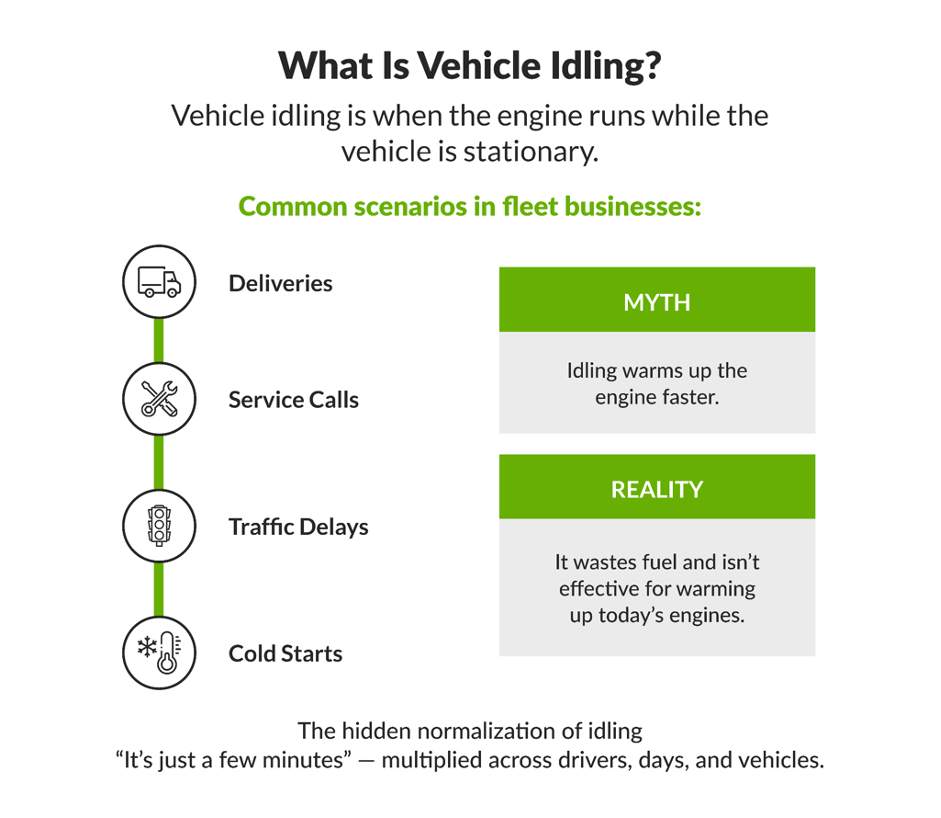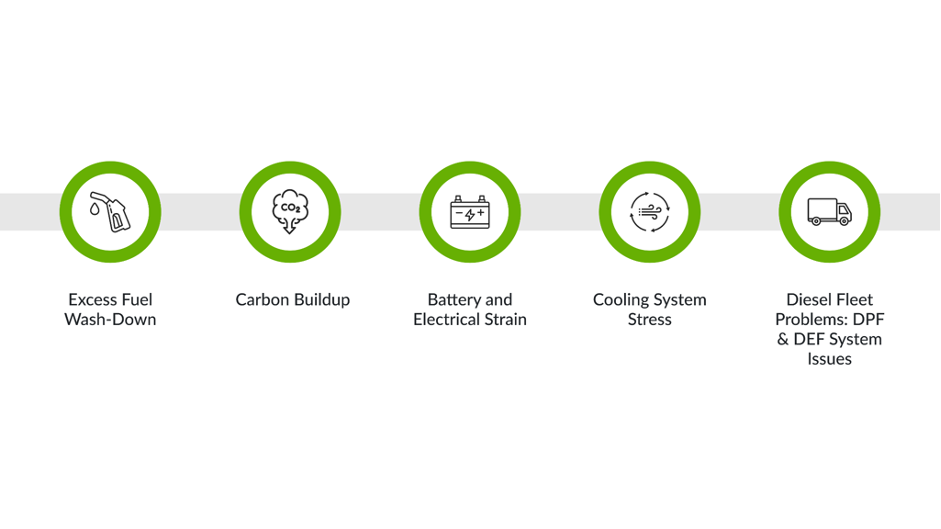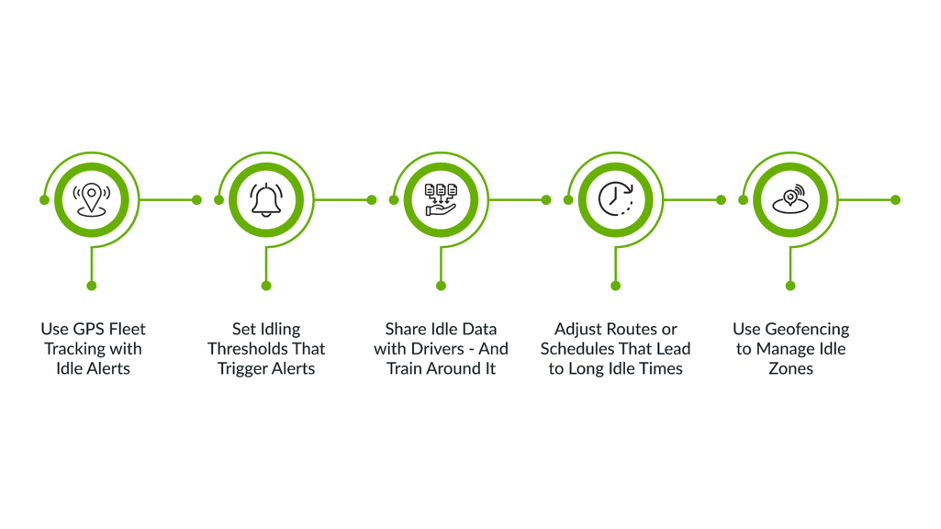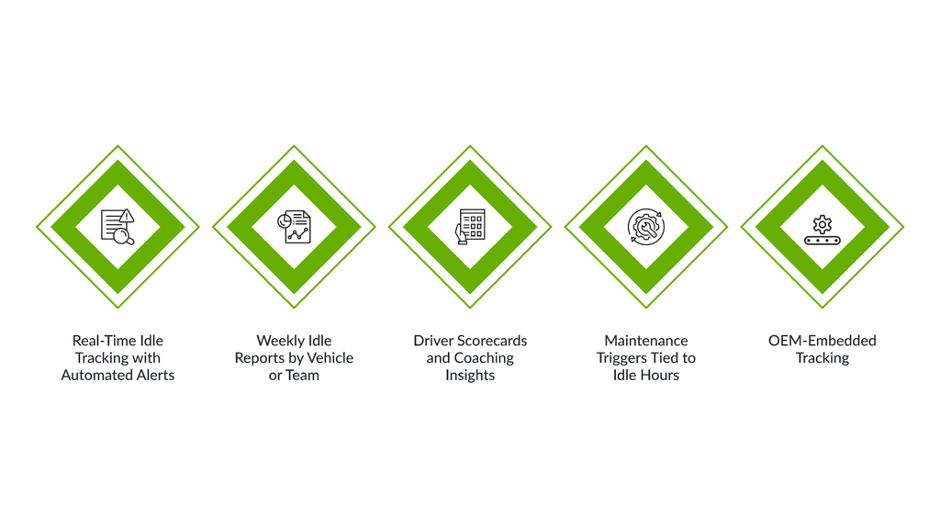Leaving the engine running while your driver grabs a coffee or waits at a job site might not seem like a big deal. It’s just a few minutes.
But when you manage a fleet, those few minutes multiply across vehicles, days, and months. The result? A slow and silent drain on your bottom line.
Business-use vehicles, including vans, pickups, and mid-sized trucks, collectively waste more than 6 billion gallons of fuel every year in the U.S. just from idling. That’s fuel burned with the wheels standing still.
| Take just one light-duty fleet vehicle—like a service van or pickup—idling for 15 minutes a day. At an average diesel price of $3.60/gallon, that’s about 29.2 gallons wasted per year, costing roughly $105.12 per vehicle for doing nothing.
Now multiply that across a small fleet. For example, 35 vans or pickups idling just 15 minutes a day waste approximately 2.8 gallons daily, adding up to $3,679.20 per year in fuel costs that don’t move a single mile. |
And fuel is just the beginning. Chronic idling causes long-term engine wear, increases maintenance cycles, and accelerates vehicle depreciation. It can even harm your company’s reputation, especially in communities with anti-idling laws or eco-conscious clients.
So, can idling your car damage it? Yes. And it’s costing your business more than you think.
What Exactly Is Vehicle Idling—and Why Does It Happen So Often in Fleets?

Vehicle idling occurs whenever the engine is running while the vehicle is stationary—no wheels are turning, no destination is being reached, but fuel is still being burned. In fleet operations, it’s incredibly common.
Just think about how a typical workday looks for your drivers:
- Waiting at job sites
- Sitting through traffic
- Letting the engine run during cold starts
- Running the AC between service calls
- Leaving the engine on during lunch or paperwork breaks
Each instance might seem like a harmless pause. But across 10, 20, or 50 vehicles—day after day—it quickly adds up. Fuel is wasted. Engine components wear faster. And yes, over time, it raises a genuine concern:
Can idling your car damage it?
For fleet owners, the answer is often yes. And the damage isn’t always visible—until it shows up in your fuel bill, maintenance log, or a premature engine replacement.
Why It’s So Common: Normalized Habits
The challenge is that idling has become a routine activity. No alarms go off. No check engine light appears. It’s just “part of the job.” But this quiet habit can lead to thousands in annual costs, especially when left unmonitored.
Driver Myth-Busting Box: Idling Edition
Here are a few common misconceptions that cause idling to go unchecked in fleets:
| Myth | Reality |
| “Idling helps warm up the engine faster.” | Modern engines warm up quicker when driven, not while sitting. |
| “It’s better to let the engine run than restart it.” | Restarting uses less fuel than idling for more than 10 seconds—and doesn’t harm the engine. |
| “New vehicles don’t suffer from idling.” | Even newer engines face carbon buildup, oil dilution, and shorter component life. |
| “We need the AC or heat during breaks.” | There are smarter ways to manage the climate without extended idle time. |
For small and mid-sized fleet businesses, managing idling isn’t about micromanaging drivers—it’s about recognizing patterns that quietly cost you money and reduce vehicle lifespan.
So, Can Idling Your Car Damage It? Yes—Here’s How

When fleet vehicles sit with the engine running—whether it’s a delivery van at a curb or a pickup waiting at a site—you’re not just burning fuel. You’re quietly accelerating mechanical wear.
So, can idling your car damage it? Yes. And here’s what it does behind the scenes, especially for light and medium-duty fleet vehicles.
1. Excess Fuel Wash-Down
When an engine idles too long, fuel doesn’t fully combust. Instead, it can wash down the cylinder walls and mix with the engine oil. Over time, this dilutes the oil’s protective properties, causing increased engine wear. That means more frequent oil changes and a higher risk of breakdowns in the field.
If you’re not tracking idle time, you’re likely shortening oil life without realizing it—and footing the maintenance bill sooner.
2. Carbon Buildup
During extended idling, the engine doesn’t run hot enough to burn off carbon deposits. This leads to a buildup on pistons, spark plugs, and exhaust valves, eventually shortening the engine’s lifespan and reducing performance.
That sluggish acceleration or engine misfire? It might not be age, it could be months of idle time catching up.
3. Battery and Electrical Strain
Modern fleet vehicles are equipped with numerous electronic components, including GPS units, tablets, cameras, lighting systems, and dispatch devices, all of which consume power even when the vehicle is idling. The alternator continues to function, but not at full charging power at low RPM. Result? Battery drain and charging system stress can leave your drivers with no-start issues or premature battery replacements.
Excessive idle time is a hidden cost in your battery budget.
4. Cooling System Stress
Idling engines—especially in the summer—can overheat when airflow is limited. Your radiator and cooling fans have to work overtime just to maintain stability. Constant thermal strain can wear out belts, hoses, and thermostats more quickly than you think.
For warm-weather fleets: Monitoring idle time is just as important as monitoring temperature gauges.
5. Diesel Fleet Problems: DPF & DEF System Issues
If you run diesel vehicles, idling is even worse. Excessive idle time leads to incomplete combustion, which clogs the Diesel Particulate Filter (DPF). Regeneration cycles may fail to complete, triggering warning lights—or worse, derating the system.
Plus, diesel exhaust fluid (DEF) systems can malfunction under prolonged idle conditions.
A blocked DPF can cost thousands to repair, and it often begins with unnoticed idle time.
And beyond mechanical wear, idle time can cost you thousands of dollars each year in wasted fuel and avoidable repairs, mainly when it occurs across your entire fleet.
Hot or Cold Weather Excuses: Is Seasonal Idling Justified?
👉 TL;DR:Seasonal idling might feel justified, but it rarely holds up under scrutiny. Modern engines no longer require lengthy warm-ups. And there are better, safer ways to keep drivers comfortable without burning fuel and inviting wear. |
One of the most common justifications drivers give for idling is simple: the weather.
“It’s freezing—we need to warm up the engine.”
“It’s too hot—we can’t sit in the van without AC.”
And sure, comfort and climate control matter—especially when your team is on the road all day. But are these seasonal idling habits really necessary? And more importantly, are they costing you more than they help?
The Cold Start Myth
It’s a holdover from the carburetor era: the idea that you need to warm up your vehicle by letting it idle.
But modern fuel-injected engines don’t need extended idle time to get going. They warm up faster when driven, not when sitting still.
| Idling in cold weather doesn’t “help” the engine—it delays optimal operating temperature and wastes fuel. |
If your drivers are letting the truck sit running for 10+ minutes in the morning “to warm up,” that’s hundreds of dollars a year going up in smoke, per vehicle.
Hot Weather AC: A Comfort Trap
When temps soar, it’s natural to want relief. But sitting in an idling vehicle with the AC on isn’t the only (or best) solution.
Extended hot-weather idling leads to:
- Overworked cooling systems
- Premature wear on fans, hoses, and belts
- Higher engine temps in confined spaces (like urban job sites)
Even worse, many vehicles left running for the AC while unattended become security risks.
Legal and Environmental Limits
It’s not just about comfort or cost. Many U.S. states and municipalities have strict anti-idling laws, especially in urban or high-traffic zones. Some limit idling to 3–5 minutes, with fines ranging from $50 to $500+, depending on the location.
If your fleet operates in states like New York, California, Massachusetts, or Washington, D.C., excessive idling can create compliance issues in addition to wasted fuel.
How to Reduce Fleet Idling Without Micromanaging Your Drivers

Telling your team to “stop idling” rarely has an effect. But giving them the right tools—and showing them how it helps them too—can drive real change. The goal isn’t to monitor your drivers like hawks. It’s to build a system that quietly keeps idling in check, without disrupting their workflow.
Here’s how to do that.
1. Use GPS Fleet Tracking with Idle Alerts
Platforms like EcoTrack Fleet Management enable you to monitor idle time across every vehicle in real-time. You’ll get instant alerts when a vehicle idles beyond your set limit, so you can address it early, not after a pattern has formed.
Bonus: With EcoTrack, idle data is available on a clean, driver-specific dashboard, so it’s easy to spot trends and take action.
2. Set Idling Thresholds That Trigger Alerts
Start with a basic rule: alert after 2–3 minutes of idle time. This gives drivers a grace period for deliveries or traffic stops but nudges them when idle behavior becomes excessive. Over time, these subtle prompts create smarter habits, without micromanagement.
3. Share Idle Data with Drivers—And Train Around It
Use weekly or monthly reports to show drivers how they’re doing. Most pros respond well to clear numbers, especially if the feedback is private and constructive.
Tip: Pair the data with a short training module or quick checklist to help drivers reduce idle time in real-world scenarios.
4. Adjust Routes or Schedules That Lead to Long Idle Times
Sometimes idling isn’t a behavior problem—it’s a planning issue. Are drivers arriving early to jobs due to poor routing? Are they stuck in lunch-hour traffic every day?
Use your GPS’s trip history to spot inefficiencies—and update schedules or routes accordingly.
5. Use Geofencing to Manage Idle Zones
Set up geofences around high-idle areas, such as loading zones or job sites, and track idle behavior within those zones. This helps you determine whether idle time is operationally necessary or can be addressed through process changes.
Example: Smart Incentives Work“Miller Plumbing reduced idle time by 37% in just 2 months. How? They utilized EcoTrack’s idle-time alerts and offered monthly gift card rewards to the top three drivers who maintained low idle times. No micromanaging—just smart motivation and clear feedback.”
|
How EcoTrack Fleet Management Solves the Idle-Time Problem

By now, you’ve probably stopped wondering, can idling your car damage it?—and started asking how to stop it from happening in the first place.
That’s exactly where EcoTrack Fleet Management steps in. It provides you with the tools to monitor idle time, correct it, and prevent the hidden wear and tear that can drag down your fleet’s performance.
Real-Time Idle Tracking with Automated Alerts
EcoTrack monitors idle time across your entire fleet and flags any vehicle that goes beyond your preset threshold—2 minutes, 5 minutes, you choose. You’ll spot the problem before it turns into wasted fuel or engine damage.
Weekly Idle Reports by Vehicle or Team
Want to see which vehicles are idling the most? Or which driver cut idle time last month? EcoTrack delivers easy-to-read weekly reports that help you make decisions without digging through spreadsheets.
Driver Scorecards and Coaching Insights
Idle-time scorecards give you a clear picture of individual driver behavior. That means you can coach smarter, reward improvement, and make idling awareness part of your team culture—without micromanaging.
Maintenance Triggers Tied to Idle Hours
Because idling isn’t just about fuel, it puts wear on your engine, oils, and emissions systems. EcoTrack connects idle time to your maintenance schedule, allowing you to plan oil changes, DPF servicing, and inspections around actual usage, not just mileage.
OEM-Embedded Tracking (No Extra Hardware Required)
If your vehicles support it, EcoTrack taps into their built-in telematics. That means no bolt-on hardware, no downtime, and faster deployment across your fleet.
If you’ve been wondering can idling your car damage it, the answer is yes—and EcoTrack gives you the data, automation, and tools to stop it at the source.
Going Green Without Going BrokeReducing idle time is one of the easiest, most cost-effective ways to: ● Improve fuel efficiency ● Lower emissions ● Extend engine life ● Protect your company’s reputation You don’t need to buy electric vehicles or overhaul your fleet. You just need to track, coach, and adjust—and EcoTrack helps you do all three.
|
Cut Idle Time, Cut Costs with EcoTrack Fleet Management
Every idle minute drains fuel, eats into labor hours, and puts unnecessary strain on your vehicles. But without visibility, it’s hard to fix what you can’t see.
That’s where EcoTrack comes in.
With Real-Time GPS Tracking, Smart Dispatch Tools, and AI-Enabled Cameras, EcoTrack gives you a full picture view of your fleet, so you can:
- Spot and reduce idle time with real-time vehicle tracking
- Assign jobs faster and reroute drivers more efficiently
- Get camera-backed visibility into jobsite behavior and on-road delays
This isn’t just tracking—it’s actionable data that helps you protect your bottom line.
Ready to See Where You’re Losing Time—and How to Take It Back?
Book your EcoTrack demo
We’ll walk you through the exact tools that help cut idle time and improve efficiency across your entire fleet.





